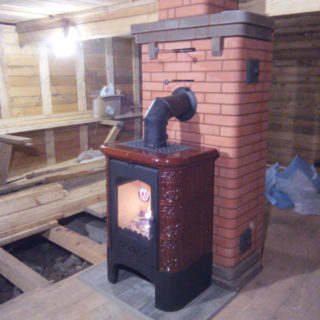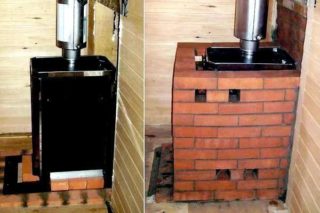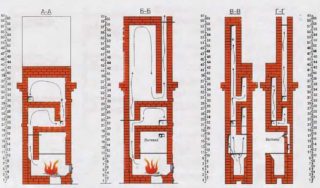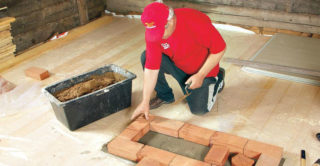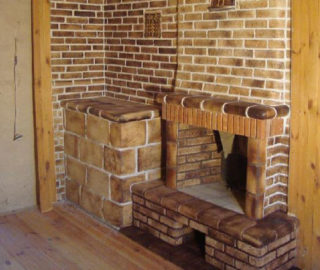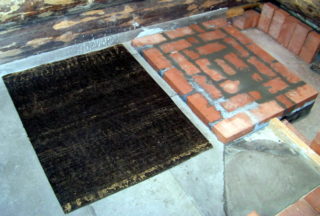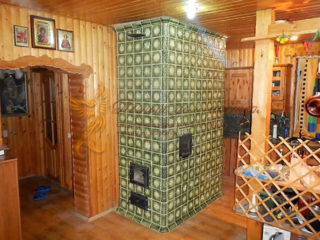An iron stove provides quick heating of the room, but it has one significant drawback. The metal cools quickly. You can solve this problem if you install a heating shield. He will be responsible for the safe and efficient operation of the entire heating structure.
The device of the heating shield
The heating shield made of bricks for the iron stove is an additional extension, a heat exchanger. Sometimes it is called a casing. This is a design with chimneys inside. Hot gas passes through them, heating the walls. Brick will retain heat for a long time and heat the room. By installing a heat shield, the efficiency of the furnace is increased. The device itself has the following advantages:
- the shield is easy to make on your own, this does not require special knowledge and skills;
- Thanks to this design, the room heats up much faster;
- heat is stored for a long time.
Installing a heating shield on a metal furnace brings it closer to a brick in properties. The design is able to retain heat for a long time, thanks to this fuel is saved.
Varieties and schemes
Heating shields are divided into two large groups:
- thin-walled;
- thick-walled.
The second option is laid out in ½ brick. This design meets the fire safety requirements as much as possible, but it has one feature: such a furnace can warm up well if it is heated for a long time.
Thin-walled guards are laid out in a quarter of a brick. To ensure fire safety, it is recommended to additionally equip metal casings.
Depending on the season of use, the devices are divided into summer and winter. Summer options warm up only partially, winter ones - completely.
Depending on the internal device, two types of shields are distinguished.
Channel
Scheme of the shield is a network of chimneys located vertically from each other. Before going outside, smoke passes through all the channels, heating them.
Bell-shaped
Such a system is used as an extension to a furnace made of cast iron. The device is equipped with two cameras that are located vertically. Gas will remain in them until it cools completely. Only after that he goes outside. Since hot smoke is inside the structure for a long time, the shield warms up much more. The main advantage of this system is the ability to install an additional valve. Thus, it will be possible to adjust the level of heating.
Channel shields are easy to fold on their own, even beginners will cope with them. Hood designs can only be trusted to professionals.
Masonry recommendations
To lay a brick guard for a metal stove in a bathhouse or a house, you need to follow the recommendations:
- The solution should be clay-based only. Do not use cement.
- During masonry, immediately remove the remaining mixture from the inside of the structure.
- Construction must begin with the installation of the foundation. It should be separate, not connected with the foundation of the house. First, the brick is laid dry to check horizontality.After checking all the parameters, the foundation is fixed with a solution.
- To limit the draft of smoke, you need to install a slide gate in the upper part of the structure.
The first two rows are laid out deaf, they do not make smoke channels. This is necessary in accordance with fire safety requirements.
Ordering
The order of the bell-type heating shield is as follows:
- Rows from first to third are laid out in a standard way. In the third row, you must leave an empty space in which the furnace door will be installed.
- A basement and a door for cleaning are mounted on the fourth and fifth rows, and two plugs are installed here.
- In the sixth row, the number of channels is gradually reduced, a heating tank is installed.
- The seventh row is for mounting the grille. So that it is securely fixed, you need to heal all the bricks that may interfere. The channel is blocked to further make two branches.
- The eighth row is designed to install two doors.
- On the ninth and tenth, a tab of steel strip is placed.
- The next stage is the implementation of door ceilings. Top they should be greased with a solution of clay.
- On the twelfth row, a cast iron plate is installed.
- On the sixteenth tier, you need to heave the bricks in the area of the right corner, and on the nineteenth, a valve is installed.
- Twenty-second row is reserved for the installation of the flap and samovar.
- To expand on the thirty-first row, the bricks are squeezed, and at the next stage, a ventilation grill is installed.
The order in all cases is individual, but based on the same principles.
Installation Safety
Increased requirements in the field of fire safety are imposed on the laying of shields for a metal stove. The shield must be laid out on a separate foundation. It is pre-waterproofed.
To eliminate the risk of fire, the first two rows are made deaf - they do not have openings for smoke channels.
Before mounting the structure, you need to make a fire finish. If the flap is adjacent to the wall of flammable material, you must separately lay the partition in the brick. If the material is non-combustible, masonry is done in half a brick. Particular attention is paid to the corner oven, here you need to make cuts between the wall and the structure on both sides. If the shield is thin-walled, it is recommended to upholstery with sheets of metal, since the wall warms up completely.
Making a heating shield with your own hands
You can fold the shield yourself. To do this, prepare the following tools:
- roulette to perform measurements, which are necessary for calculating the area: on the basis of the data obtained, the amount of material necessary for the work is determined;
- level with which you can control the masonry vertically and horizontally;
- plumb line and cord;
- trowel for applying mortar;
- screwdriver, drill;
- angle grinder;
- tools for joint stitching;
- diamond cutting discs;
- containers for the preparation of a solution of sand and clay.
For masonry from materials, you need to purchase refractory bricks, sand and clay for the mixture. It is recommended to purchase 2 meters of roofing material for waterproofing.
Before starting work, you need to prepare bricks of about 300 pieces, five buckets of clean sand, the same amount of clay buckets. It must be cleaned of debris and dirt. In addition, three small doors, three smoke dampers, a grill will be required. All these devices are necessary to clean the passages of soot and ash.
Prior to the calculation of the main structure, a layer of brick is placed, which is covered with roofing material.It should not be above floor level. The next row should be at floor level. Further work is as follows:
- After the foundation are the first three rows in accordance with the existing order. In the fourth and fifth row you need to make a small window through which you can clean the aisles.
- In the sixth row, two channels are made, then the masonry continues, relying on even and odd layers.
- In the seventeenth row, a valve is mounted in the structure, on the twenty-first row a samovar is laid. It will be completely blocked on the 27th layer, after which all the channels on the left are united among themselves.
- On the thirty row, a valve is installed. Further work continues until the thirty-sixth row. It is necessary to leave gaps in it, which are called smoke or ventilation ducts.
If you lay out the shield for the furnace, which will have its own firebox, the volume of materials will almost double.
Heating guards will always remain popular despite a wide range of modern fireplaces. The advantage of the design is that it accumulates heat and acts as a decorative element in the interior.
The brick shield accumulates very quickly and retains heat for a long time, unlike massive stoves it takes up very little space. The most suitable for saving space are considered corner structures. Such a shield fits perfectly into a small room. It is easy to do it yourself, observing the principles of ordering.
Before choosing a design option, it is necessary to draw up a separate project. It includes an accurate calculation of the amount of materials, the size of the room, the presence of insulation.
The heating brick shield, which is made in accordance with all the rules and optimal parameters, will provide a good level of heating, and will cost much cheaper than a large stove.
